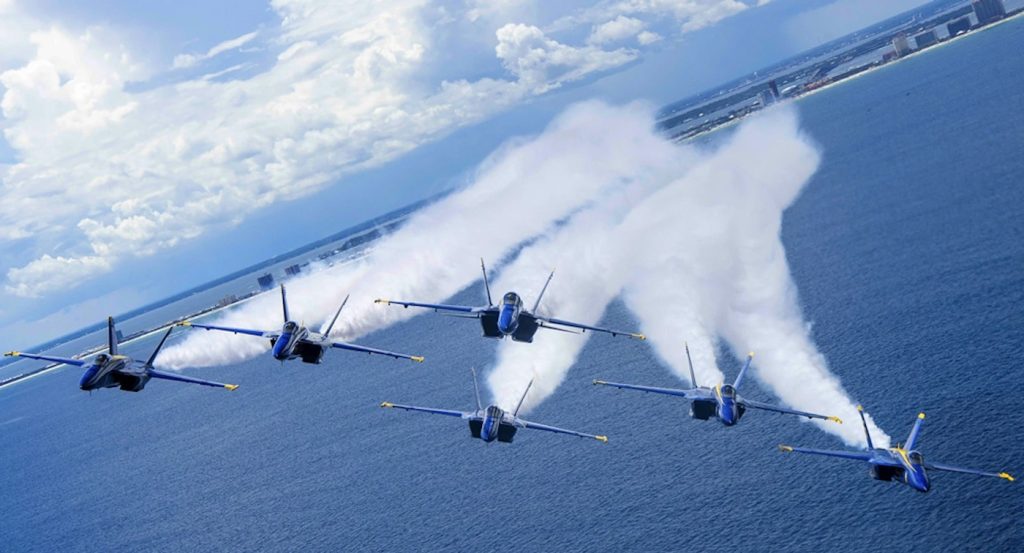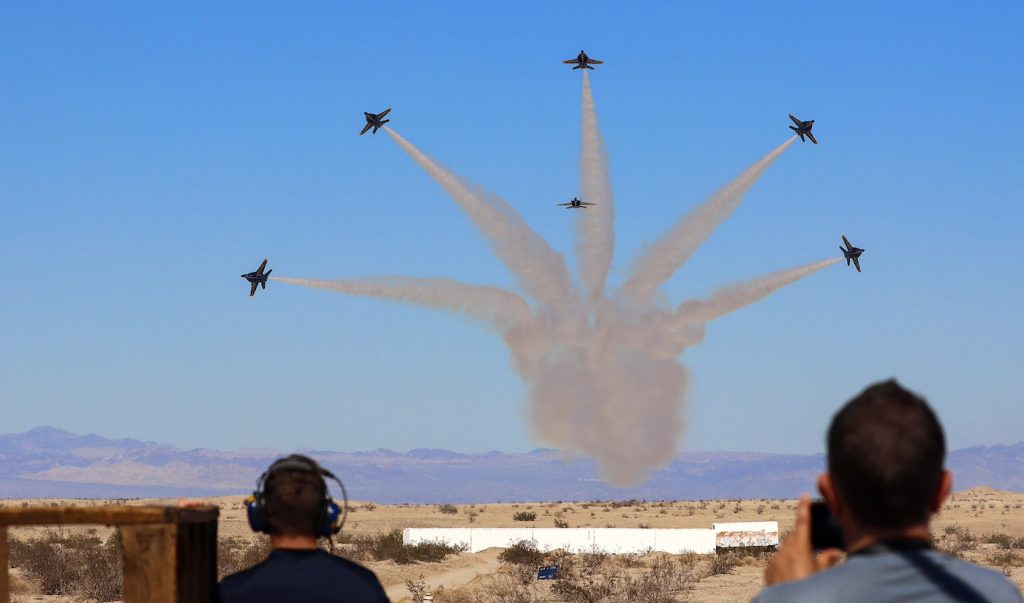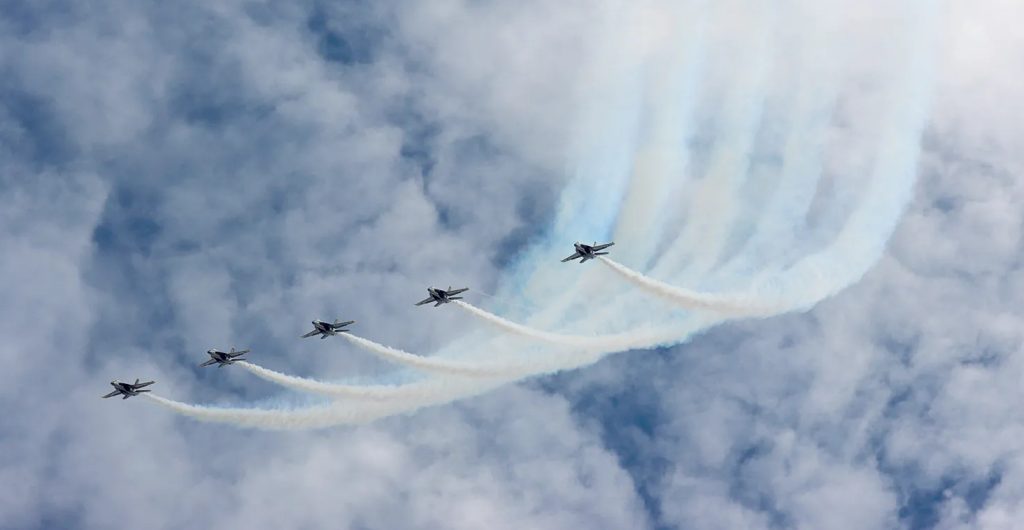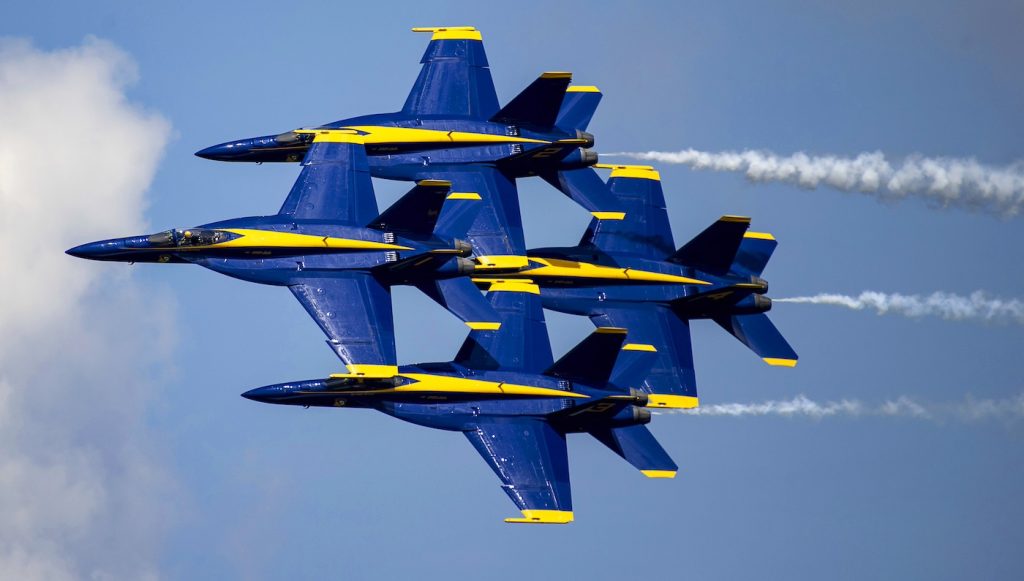Chasing Precision and Perfection with Aerial DPs on “The Blue Angels” – Part 2
In the last installment, former Blue Angels pilot LCDR Lance “Bubb” Benson, aerial DP Michael FitzMaurice, and aerial coordinator Kevin LaRosa II shared how the painstaking planning process really paid off and the use of Benson’s “chase” jet to capture unique vantage points. Now, we delve into the camera configurations and what it took to film some of the most popular maneuvers from the air.
The sizeable discrepancy between the airspeeds of the helicopter and the F-18s was crucial in intensifying the visceral rush on-screen. “That’s a bonus in our world—having dissimilar platforms helps you create a dynamic shot with a lot of energy and speed,” LaRosa reveals. “Michael does some fantastic whip-panning as the jets go by to create a lot of movement to show how quickly the jets are moving.” To ensure maximum safety, they had to be in the right spot at the right time, which they accomplished by studying every maneuver in detail. “We put the GPS ground tracking data into Google Earth and studied a three-dimensional airshow and learned every position of every jet, which also included abnormal situations with weather, where they would do a flat show or a low show versus a high show. We memorized the different configurations and plotted where to put the helicopter to create the most dynamic shots. So, we knew where we needed to be and how we’re going to do it before we ever got in the air.”
To capture the adrenaline-inducing maneuvers, “the primary camera on the helicopter was a Sony Venice 2 in a Shotover K1 gimbal. We wanna give a shoutout to our Shotover gimbal technician, Jared Slater. Without that, we would’ve captured nothing!” FitzMaurice explains. “In the helicopter, we also used the Phantom Flex 4k, which gave us the 1,000 frames-per-second slow-motion footage. That’s when the jets looked like they were almost perfectly still, and all the vapors were coming off of them.” The cameras mounted to the exterior of Benson’s “chase” F-18 reveals the Top Gun: Maverick DNA in this film. Since LaRosa and FitzMaurice worked on the 2022 blockbuster, “Kevin and I reached out to the Maverick team at Paramount to get the camera mounts that were custom-made for Maverick, which was already approved by the Navy,” FitzMaurice reveals. “We used Sony Venice 1s because they were approved for that camera mount at the time. That’s why we didn’t use the Venice 2 on the chase jet.”

When the cameras were mounted on two pylons (where the weapons would normally be) under the wings of the chase jet, Benson flew a single-seater F-18 to capture maneuvers such as the “Knife Edge Pass.” “Two jets come very close to each other and roll up on a wing, it looks like their noses kind of touch and almost hit as they pass each other. I was right next to #5 as he was coming in,” he says, adding: “There’s over 800 knots of closure as those jets go by each other. With the camera on the pylon looking right at that maneuver, you see one jet rolling up on its wing and then another jet just in the blink of an eye going right by within 40 feet. It’s really an exciting point of view.” Another maneuver is the “Fleur de Lis,” where all six jets pull in and break apart in a dramatic breakout, and the diamond forms over the top of the loop. “We were trying to capture that diamond coming together at the top, so there are some really unique vantage points that you rarely see.”
The quintessential IMAX project if there ever was one, the film delivers never-before-seen angles to maneuvers that have thrilled countless fans on the ground. “When they did the “Delta Breakout” [aka the “fan break”], we were right on their line with all six jets coming straight at us. After they all broke out above us, the #4 jet kept coming straight at us. He called out on the radio that he saw us and would get as close as he could to us. It’s a great shot in the movie where that jet comes right at you and goes right underneath the camera,” FitzMaurice shares.

On the “High Alpha Pass,” two of the jets flew as slow as they could in front of the crowd. “At about 120 knots, which is very slow for a jet that size, that gave our helicopter a chance to get in there and fly in formation with them. Where most of the high-speed passes required Michael to do some amazing operating to keep them in the frame, this was a rare chance to stay with the F-18s and create this cool parallax with a wide-angle lens because we were only 20 feet away. So that was pretty awesome,” says LaRosa. “That’s when #5 and #6 are angled up and going really slow, blowing smoke out the back. I think that might be the closest a civilian helicopter has ever been to an F-18 in-flight without getting hit,” FitzMaurice adds.

Another impressive element for LaRosa was the “MRT,” or Minimum Radius Turn: “We did a lot of planning to get the camera as close to the afterburners as possible. As the aircraft was doing the MRT before the crowd with full afterburner, we stuck the helicopter on the inside of that turn. Being a slower platform gave us an advantage because we could stay with this jet a little longer,” he says. Another Blue Angels signature maneuver is the “Diamond 360,” one of the most challenging maneuvers that showcases the team’s extreme precision as four jets fly within 18 inches of each other from wingtip to canopy. “Four jets come from the crowd’s right shoulder, and they’re as tight as they’ll get for the entire demo. Each jet is within 18 inches from the top of the canopy to the underside of the wing of the jet above it. For this one, Michael was in the back seat. We tucked ourselves tight underneath so it looked like there was a fifth jet. He had a wide-angle lens looking back towards the crowd, which is a position that normally only #2 or #4 get to see as it goes down the show line,” says Benson.
The Maverick connection doesn’t end with the camera mounts and the aerial team—Maverick co-star Glen Powell is one of the producers who ultimately connected executive producer Greg Wooldridge—the only three-time Boss of the Blue Angels—to Crowder in the early stages of the project. “Boss Wooldridge was very involved in approaching Boss Kesserling about making this documentary to show the public what the Blue Angels is all about. Having served as Boss three times, he knew how to avoid the distractions and only go to Boss Kesserling for what was absolutely needed,” Benson reveals.
Beyond thrilling audiences with gravity-defying aerial displays, the film humanizes the Blue Angels by highlighting their dedication to each other and the mission and their unrelenting pursuit of excellence every day on the job. Boss Wooldridge echoes the sentiment, saying at one point in the film: “We’ll never get to perfection, but along the way, we’re going to realize excellence.” After spending some time with the team, LaRosa walked away absolutely inspired by the experience: “They’re a very driven and incredibly high-performing team, which empowers you. We got to spend a fraction of a moment in the team’s history, which was pretty incredible.”
For Benson, this cinematic love letter to naval aviation is an amazing opportunity to share his passion with the next generation. “I’m super excited that everyone will get to see this film. For guys my age, the original Top Gun movie got everybody excited about naval aviation. I hope this documentary will encourage a younger generation to serve their country and want to fly fighter jets and, maybe one day, become a Blue Angel.”
The Blue Angels is streaming now on Amazon Prime.
For more on Amazon Prime Video, check out these stories:
Nicolas Cage set to Star in Live-Action Spider-Man Noir Series
“Blade Runner 2099” Adds Michelle Yeoh to Cast in Leading Role
Featured image: “Blue Angels.” Courtesy Amazon MGM.




